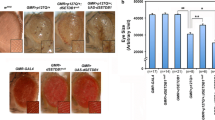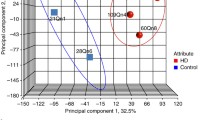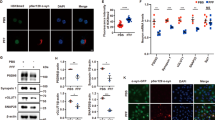Abstract
Huntington’s disease (HD) is a disease characterized by the progressive degeneration of nerve cells in the brain. DNA damage has been implicated in many neurological disorders; however, the association between this damage and the impaired signaling related to neurodegeneration is still unclear. The transcription factor c-AMP-responsive element binding protein (CREB) has a relevant role in the neuronal plasticity process regulating the expression of several genes, including brain-derived neurotrophic factor (BDNF). Here we analyzed the direct link between DNA damage and the expression of genes involved in neuronal plasticity. The study was performed in model cell lines STHdhQ7 (wild type) and STHdhQ111 (HD model). Treatment with Etoposide (Eto) was used to induce double-strand breaks (DSBs) to evaluate the DNA damage response (DDR) and the expression of synaptic plasticity genes. Eto treatment induced phosphorylation of ATM (p-ATM) and H2AX (γH2AX), markers of DDR, in both cell lines. Interestingly, upon DNA damage, STHdhQ7 cells showed increased expression of activity-regulated cytoskeleton associated protein (Arc) and BDNF when compared to the HD cell line model. Additionally, Eto induced CREB activation with a differential localization of its co-activators in the cell types analyzed. These results suggest that DSBs impact differentially the gene expression patterns of plasticity genes in the normal cell line versus the HD model. This effect is mediated by the impaired localization of CREB-binding protein (CBP) and histone acetylation in the HD model. Our results highlight the role of epigenetics and DNA repair on HD and therefore we suggest that future studies should explore in depth the epigenetic landscape on neuronal pathologies with the goal to further understand molecular mechanisms and pinpoint therapeutic targets.





Similar content being viewed by others
Data Availability
The datasets generated during and/or analyzed during the current study are available by request; please contact the corresponding author.
References
Vonsattel J-P, Myers RH, Stevens TJ et al (1985) Neuropathological classification of Huntington’s disease. J Neuropathol Exp Neurol 44:559–577. https://doi.org/10.1097/00005072-198511000-00003
Montoya A, Price BH, Menear M, Lepage M (2006) Brain imaging and cognitive dysfunctions in Huntington’s disease. J Psychiatr Neurosci 31(1):21–29
MacDonald ME, Ambrose CM, Duyao MP et al (1993) A novel gene containing a trinucleotide repeat that is expanded and unstable on Huntington’s disease chromosomes. Cell 72:971–983. https://doi.org/10.1016/0092-8674(93)90585-E
Browne SE, Beal MF (2004) The energetics of Huntington’s disease. Neurochem Res 29:531–546. https://doi.org/10.1023/B:NERE.0000014824.04728.dd
Browne SE, Beal MF (2006) Oxidative damage in Huntington’s disease pathogenesis. Antioxid Redox Signal 8:2061–2073. https://doi.org/10.1089/ars.2006.8.2061
Lin MT, Beal MF (2006) Mitochondrial dysfunction and oxidative stress in neurodegenerative diseases. Nature 443:787–795. https://doi.org/10.1038/nature05292
Jeon GS, Kim KY, Hwang YJ et al (2012) Deregulation of BRCA1 leads to impaired spatiotemporal dynamics of γ-H2AX and DNA damage responses in Huntington’s disease. Mol Neurobiol 45:550–563. https://doi.org/10.1007/s12035-012-8274-9
Giralt A, Rodrigo T, Martín ED et al (2009) Brain-derived neurotrophic factor modulates the severity of cognitive alterations induced by mutant huntingtin: involvement of phospholipaseCγ activity and glutamate receptor expression. Neuroscience 158:1234–1250. https://doi.org/10.1016/j.neuroscience.2008.11.024
Giralt A, Puigdellívol M, Carretón O et al (2012) Long-term memory deficits in Huntington’s disease are associated with reduced CBP histone acetylase activity. Hum Mol Genet 21:1203–1216. https://doi.org/10.1093/hmg/ddr552
Lione LA, Carter RJ, Hunt MJ et al (1999) Selective discrimination learning impairments in mice expressing the human Huntington’s disease mutation. J Neurosci 19:10428–10437. https://doi.org/10.1523/JNEUROSCI.19-23-10428.1999
Simmons DA, Rex CS, Palmer L et al (2009) Up-regulating BDNF with an ampakine rescues synaptic plasticity and memory in Huntington’s disease knockin mice. Proc Natl Acad Sci 106:4906–4911. https://doi.org/10.1073/pnas.0811228106
Barco A, Pittenger C, Kandel ER (2003) CREB, memory enhancement and the treatment of memory disorders: promises, pitfalls and prospects. Expert Opin Ther Targets 7:101–114. https://doi.org/10.1517/14728222.7.1.101
Kandel ER (2001) The molecular biology of memory storage: a dialogue between genes and synapses. Science 294:1030–1038. https://doi.org/10.1126/science.1067020
Silva AJ, Kogan JH, Frankland PW, Kida S (1998) CREB and memory. Annu Rev Neurosci 21:127–148. https://doi.org/10.1146/annurev.neuro.21.1.127
Conkright MD, Canettieri G, Screaton R et al (2003) TORCs: transducers of regulated CREB activity. Mol Cell 12:413–423. https://doi.org/10.1016/j.molcel.2003.08.013
Li S, Zhang C, Takemori H et al (2009) TORC1 regulates activity-dependent CREB-target gene transcription and dendritic growth of developing cortical neurons. J Neurosci 29:2334–2343. https://doi.org/10.1523/JNEUROSCI.2296-08.2009
Ravnskjaer K, Kester H, Liu Y et al (2007) Cooperative interactions between CBP and TORC2 confer selectivity to CREB target gene expression. EMBO J 26:2880–2889. https://doi.org/10.1038/sj.emboj.7601715
Steffan JS, Kazantsev A, Spasic-Boskovic O et al (2000) The Huntington’s disease protein interacts with p53 and CREB-binding protein and represses transcription. Proc Natl Acad Sci 97:6763–6768. https://doi.org/10.1073/pnas.100110097
Korzus E, Rosenfeld MG, Mayford M (2004) CBP histone acetyltransferase activity is a critical component of memory consolidation. Neuron 42:961–972. https://doi.org/10.1016/j.neuron.2004.06.002
Cong S-Y, Pepers BA, Evert BO et al (2005) Mutant huntingtin represses CBP, but not p300, by binding and protein degradation. Mol Cell Neurosci 30:12–23. https://doi.org/10.1016/j.mcn.2005.05.003
Morrison BE, Majdzadeh N, D’Mello SR (2007) Histone deacetylases: focus on the nervous system. Cell Mol Life Sci 64:2258–2269. https://doi.org/10.1007/s00018-007-7035-9
Abel T, Zukin RS (2008) Epigenetic targets of HDAC inhibition in neurodegenerative and psychiatric disorders. Curr Opin Pharmacol 8:57–64. https://doi.org/10.1016/j.coph.2007.12.002
Jia H, Pallos J, Jacques V et al (2012) Histone deacetylase (HDAC) inhibitors targeting HDAC3 and HDAC1 ameliorate polyglutamine-elicited phenotypes in model systems of Huntington’s disease. Neurobiol Dis 46:351–361. https://doi.org/10.1016/j.nbd.2012.01.016
Cohen-Cory S, Kidane AH, Shirkey NJ, Marshak S (2010) Brain-derived neurotrophic factor and the development of structural neuronal connectivity. Dev Neurobiol 70:271–288. https://doi.org/10.1002/dneu.20774
Benito E, Barco A (2010) CREB’s control of intrinsic and synaptic plasticity: implications for CREB-dependent memory models. Trends Neurosci 33:230–240. https://doi.org/10.1016/j.tins.2010.02.001
Madabhushi R, Gao F, Pfenning AR et al (2015) Activity-induced DNA breaks govern the expression of neuronal early-response genes. Cell 161:1592–1605. https://doi.org/10.1016/j.cell.2015.05.032
Trettel F, Rigamonti D, Hilditch-Maguire P et al (2000) Dominant phenotypes produced by the HD mutation in STHdhQ111 striatal cells. Hum Mol Genet 9:2799–2809. https://doi.org/10.1093/hmg/9.19.2799
Covarrubias-Pinto A, Moll P, Solís-Maldonado M et al (2015) Beyond the redox imbalance: oxidative stress contributes to an impaired GLUT3 modulation in Huntington’s disease. Free Radic Biol Med 89:1085–1096. https://doi.org/10.1016/j.freeradbiomed.2015.09.024
Sakamoto K, Karelina K, Obrietan K (2011) CREB: a multifaceted regulator of neuronal plasticity and protection. J Neurochem 116:1–9. https://doi.org/10.1111/j.1471-4159.2010.07080.x
Pregi N, Belluscio LM, Berardino BG et al (2017) Oxidative stress-induced CREB upregulation promotes DNA damage repair prior to neuronal cell death protection. Mol Cell Biochem 425:9–24. https://doi.org/10.1007/s11010-016-2858-z
Wang H, Lautrup S, Caponio D et al (2021) DNA damage-induced neurodegeneration in accelerated ageing and Alzheimer’s disease. Int J Mol Sci 22(13):6748
Maiuri T, Suart CE, Hung CLK et al (2019) DNA damage repair in Huntington’s disease and other neurodegenerative diseases. Neurotherapeutics 16:948–956. https://doi.org/10.1007/s13311-019-00768-7
Gonzalez-Hunt CP, Sanders LH (2021) DNA damage and repair in Parkinson’s disease: recent advances and new opportunities. J Neurosci Res 99:180–189. https://doi.org/10.1002/jnr.24592
Moshell AN, Barrett SF, Tarone RE, Robbins JH (1980) Radiosensitivity in Huntington’s disease: implications for pathogenesis and presymptomatic diagnosis. Lancet 315:9–11. https://doi.org/10.1016/S0140-6736(80)90550-4
Robison SH, Bradley WG (1984) DNA damage and chronic neuronal degenerations. J Neurol Sci 64:11–20. https://doi.org/10.1016/0022-510X(84)90051-0
Massey TH, Jones L (2018) The central role of DNA damage and repair in CAG repeat diseases. Dis Model Mech. https://doi.org/10.1242/dmm.031930
Enokido Y, Tamura T, Ito H et al (2010) Mutant huntingtin impairs Ku70-mediated DNA repair. J Cell Biol 189:425–443. https://doi.org/10.1083/jcb.200905138
Iyer RR, Pluciennik A (2021) DNA mismatch repair and its role in Huntington’s disease. J Huntingtons Dis 10:75–94. https://doi.org/10.3233/JHD-200438
Cha J-HJ (2000) Transcriptional dysregulation in Huntington’s disease. Trends Neurosci 23:387–392. https://doi.org/10.1016/S0166-2236(00)01609-X
Sugars KL, Rubinsztein DC (2003) Transcriptional abnormalities in Huntington disease. Trends Genet 19:233–238. https://doi.org/10.1016/S0168-9525(03)00074-X
Zuccato C, Ciammola A, Rigamonti D et al (2001) Loss of huntingtin-mediated BDNF gene transcription in Huntington’s disease. Science 293:493–498. https://doi.org/10.1126/science.1059581
Zuccato C, Liber D, Ramos C et al (2005) Progressive loss of BDNF in a mouse model of Huntington’s disease and rescue by BDNF delivery. Pharmacol Res 52:133–139. https://doi.org/10.1016/j.phrs.2005.01.001
Zuccato C, Cattaneo E (2007) Role of brain-derived neurotrophic factor in Huntington’s disease. Prog Neurobiol 81:294–330. https://doi.org/10.1016/j.pneurobio.2007.01.003
dos Santos NAG, Ferreira RS, dos Santos AC (2020) Overview of cisplatin-induced neurotoxicity and ototoxicity, and the protective agents. Food Chem Toxicol. https://doi.org/10.1016/j.fct.2019.111079
Sun Y-X, Yang J, Wang P-Y et al (2013) Cisplatin regulates SH-SY5Y cell growth through downregulation of BDNF via miR-16. Oncol Rep 30:2343–2349. https://doi.org/10.3892/or.2013.2731
Abdelkader NF, Saad MA, Abdelsalam RM (2017) Neuroprotective effect of nebivolol against cisplatin-associated depressive-like behavior in rats. J Neurochem 141:449–460. https://doi.org/10.1111/jnc.13978
Han M, Ban J-J, Bae J-S et al (2017) UV irradiation to mouse skin decreases hippocampal neurogenesis and synaptic protein expression via HPA axis activation. Sci Rep 7:15574. https://doi.org/10.1038/s41598-017-15773-z
Disterhoft JF, Oh MM (2006) Learning, aging and intrinsic neuronal plasticity. Trends Neurosci 29:587–599. https://doi.org/10.1016/j.tins.2006.08.005
Nucifora FC, Sasaki M, Peters MF et al (2001) Interference by huntingtin and atrophin-1 with CBP-mediated transcription leading to cellular toxicity. Science 291:2423–2428. https://doi.org/10.1126/science.1056784
Wu Z, Huang X, Feng Y et al (2006) Transducer of regulated CREB-binding proteins (TORCs) induce PGC-1α transcription and mitochondrial biogenesis in muscle cells. Proc Natl Acad Sci 103:14379–14384. https://doi.org/10.1073/pnas.0606714103
Chaturvedi RK, Hennessey T, Johri A et al (2012) Transducer of regulated CREB-binding proteins (TORCs) transcription and function is impaired in Huntington’s disease. Hum Mol Genet 21:3474–3488. https://doi.org/10.1093/hmg/dds178
Barrett RM, Wood MA (2008) Beyond transcription factors: The role of chromatin modifying enzymes in regulating transcription required for memory. Learn Mem 15:460–467. https://doi.org/10.1101/lm.917508
Peleg S, Sananbenesi F, Zovoilis A et al (2010) Altered histone acetylation is associated with age-dependent memory impairment in mice. Science 328:753–756. https://doi.org/10.1126/science.1186088
Nelson ED, Monteggia LM (2011) Epigenetics in the mature mammalian brain: effects on behavior and synaptic transmission. Neurobiol Learn Mem 96:53–60. https://doi.org/10.1016/j.nlm.2011.02.015
Guan J-S, Haggarty SJ, Giacometti E et al (2009) HDAC2 negatively regulates memory formation and synaptic plasticity. Nature 459:55–60. https://doi.org/10.1038/nature07925
Srivas S, Thakur MK (2017) Epigenetic regulation of neuronal immediate early genes is associated with decline in their expression and memory consolidation in scopolamine-induced amnesic mice. Mol Neurobiol 54:5107–5119. https://doi.org/10.1007/s12035-016-0047-4
Singh P, Thakur MK (2018) Histone deacetylase 2 inhibition attenuates downregulation of hippocampal plasticity gene expression during aging. Mol Neurobiol 55:2432–2442. https://doi.org/10.1007/s12035-017-0490-x
Chen G, Zou X, Watanabe H et al (2010) CREB binding protein is required for both short-term and long-term memory formation. J Neurosci 30:13066–13077. https://doi.org/10.1523/JNEUROSCI.2378-10.2010
Acknowledgements
We thank Francisco J. Morera, Ph.D., from Universidad Austral de Chile, for the helpful discussions of the results. We thank Claudia A. Tapia-Alveal, PhD., from Columbia University New York, U.S.A., for her critical reading of the manuscript.
Funding
This work was supported by grants FONDECYT REGULAR 1141067 (to A.Z.) and 1191620 (M.A.C), and VIDCA from Universidad Austral de Chile.
Author information
Authors and Affiliations
Contributions
MC and AZ., conceived and designed the experiment; JS., AC., CC., CP-M. and AZ. performed experiments and acquired the data; JS., AC., MC., and AZ., analyzed and interpreted the data; FS., MC., CO., and AZ. drafted, edited, and revised manuscript.
Corresponding author
Ethics declarations
Conflicts of interest
The authors declare no conflict of interest. The founding sponsors had no role in the design of the study; in the collection, analyses, or interpretation of data; in the writing of the manuscript, and in the decision to publish the results.
Additional information
Publisher's Note
Springer Nature remains neutral with regard to jurisdictional claims in published maps and institutional affiliations.
Rights and permissions
Springer Nature or its licensor (e.g. a society or other partner) holds exclusive rights to this article under a publishing agreement with the author(s) or other rightsholder(s); author self-archiving of the accepted manuscript version of this article is solely governed by the terms of such publishing agreement and applicable law.
About this article
Cite this article
Spies, J., Covarrubias-Pinto, A., Carcamo, C. et al. Modulation of Synaptic Plasticity Genes Associated to DNA Damage in a Model of Huntington’s Disease. Neurochem Res 48, 2093–2103 (2023). https://doi.org/10.1007/s11064-023-03889-w
Received:
Revised:
Accepted:
Published:
Issue Date:
DOI: https://doi.org/10.1007/s11064-023-03889-w




